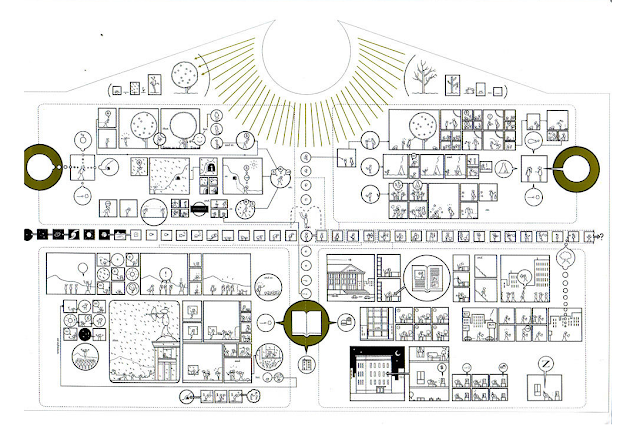Diagrammatic sequencing
Chris Ware displays a lot of diagrammatic sequencing throughout his work. It is clear he uses a formal layout making it easy for the reader to flow through his images in a non-linear way.
 |
| Figure 1 - Valencia Mural, San Francisco, 2002. |
The diagram was commissioned by Dave Egger and shows the way in which our need for food, sex and shelter drives civilisation and the development of thought speech and writing. It was on the side of a writing centre in San Francisco at a much larger scale than first anticipated.
 |
| Figure 2 - Quimby Mouse, Diagrammatic Sequencing . Illustrated in The Amce Novelty Library, 1995. |
Quimby mouse is a classic example of diagrammatic sequencing. It shows the story of his treatment of Sparky which Ware has said to have been inspired by Georgia Herriman's 'Krazy Kat'. It furthers comic language diagrams through the use of iconic, theatrical, temporal and musical properties. It further tells us the story of Quimby's treatment of Sparky and of his regret, years later, for his cruelty. The image is strong in terms of its use of symbols and therefore recreating the image was simple. This is my own take on diagrammatic sequencing inspired by Quimby Mouse. My image shows the thought process of a teenage girl including boys, clothes and girl talk with friends. I used elements from Quimby mouse including the geometric shapes linking the thoughts and ideas together.
 |
| Own Example of Diagrammatic Sequencing. |
Image References:
Figure 1 - Valencia Mural, San Francisco, 2002.
Figure 2 - Figure 2 - Quimby Mouse, Diagrammatic Sequencing . Illustrated in The Amce Novelty Library, 1995.
[1] Raeburn, D. (2004)
Bibliography:
- 826 Valencia facade postcards (2003) Available at: http://www.acmenoveltyarchive.org/item.php?item_no=96
No comments:
Post a Comment